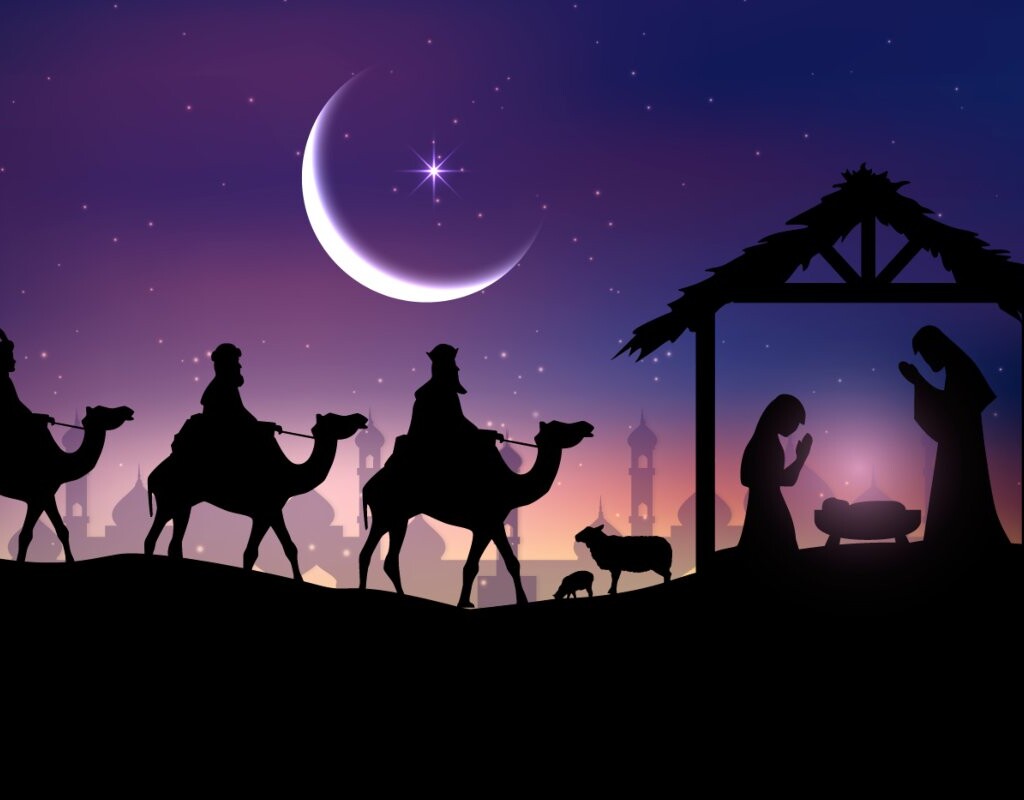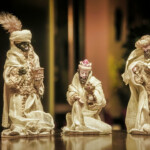The figure of the Three Wise Men has evolved from its origins in Mesopotamian practices to become icons of Christmas. Melchior, Gaspar, and Balthazar, representatives of wisdom and diversity, are celebrated in traditions that blend culture, spirituality, and symbolism.
The History and Symbolism of the Three Wise Men in Christmas
The Three Wise Men, traditionally known as Melchior, Gaspar, and Balthazar, embody a universal symbol of generosity and devotion that transcends the purely religious sphere.
According to the Gospel of Matthew (2:1-12), these sages arrived from the East guided by a star to worship the Child Jesus and offer him three gifts laden with profound symbolism: gold, frankincense, and myrrh. This account, widely disseminated in Christendom, shaped one of the most ingrained Christmas legends in various cultures.
However, the history of the Three Wise Men has even older roots that could trace back to ancient Mesopotamian practices over 4,000 years ago.
In those early records, “magicians” or “soothsayers” were mentioned as individuals tasked with predicting the future and providing wise counsel to royalty. Consequently, the tradition merged traits from different cultural influences to give rise to the most well-known version, where Melchior, Gaspar, and Balthazar, representing diverse origins, pay homage to the Child Jesus.
As a result, the word “magus” comes from ancient Persian and described wise individuals dedicated to studying the stars. This detail explains the strong connection between the Three Wise Men and the star that guided them to Bethlehem, the central axis of the Christian narrative.
Three Wise Men: Evolution Through the Centuries
Over the centuries, the figure of the Three Wise Men was enriched with medieval tales, customs rooted in Christianized Europe, and artistic interpretations that reflected the sensibilities of each era. By the 4th century AD, their mention in Christian accounts was becoming consolidated, and by the 11th century, the Feast of the Epiphany or the Adoration of the Magi was celebrated on January 6th.
Additionally, the concept of the Epiphany gained significance in the liturgical calendar to the point of becoming an essential tradition to commemorate the manifestation of Jesus to the pagan world represented by these sages.
On the other hand, in the Middle Ages, the custom of depicting the journey of the Three Wise Men through processions and dramatizations in churches became popular. They were even given the title of “kings,” although the original scriptures describe them only as magi or wise men. This adjustment responded to the desire to exalt their importance and rank of dignity in a sacred event.
During the Roman era, the Magi also acquired connotations associated with sun worship, and their gifts (gold, frankincense, and myrrh) came to symbolize aspects such as the royalty, divinity, and humanity of Jesus. Meanwhile, in Spanish popular tradition, these three characters were assimilated as part of the Christmas celebration until they became the central figures who bring gifts to boys and girls during the night of January 5th to 6th.
Cultural Interpretations of the Three Wise Men in Various Countries
Throughout history, numerous cultures have incorporated the Three Wise Men into their Christmas narratives and, at times, adapted the legend to their own idiosyncrasies.
Spain
Perhaps the country where the tradition of the Three Wise Men is most deeply rooted. There, Melchior, Gaspar, and Balthazar parade through the streets in grand cavalcades on January 5th, distributing candies and hopes. The next day, families gather to enjoy the typical Roscón de Reyes, a sweet bread decorated with candied fruits that symbolizes the jewels of royal crowns.
Greece
The legend of the “Three Merry Kings” became popular, who, amid laughter and songs, travel to the manger to worship the Child Jesus. In this version, the festive and playful aspect of the journey is emphasized while maintaining the three essential gifts: gold, frankincense, and myrrh.
Mexico
There are two popular versions that narrate the arrival of Melchior, Gaspar, and Balthazar. The first describes the Three Wise Men from the East seeking a humble manger, and the second incorporates two Mexican siblings as part of the entourage tasked with bringing aid to the newborn Child God. Both stories reflect the mestizo nature of Mexican culture, blending European tradition with local elements.
France
The “Rois Mages d’Orient” ride camels to head to Bethlehem, first passing by King Herod’s palace in search of directions about the Messiah’s birthplace. This version alludes to the dialogue with Herod and emphasizes the divine mission of the Three Wise Men, which contrasts with the monarch’s fears about the arrival of a new king.
Contemporary Traditions
In Latin America and parts of Europe, January 6th is known as Three Kings’ Day, when families share the Rosca or Roscón, and children receive gifts on behalf of the sages from the East. Additionally, colorful culinary traditions and rituals have been established, making this date an unforgettable moment.
On the other hand, globalization has facilitated the spread of the Three Wise Men in contexts where the figure of Santa Claus previously predominated. Nevertheless, in some regions, both customs coexist seamlessly, enriching the festive imagination. Therefore, children eagerly await the arrival of these three generous characters, keeping the magic of Christmas alive for a period that usually extends beyond December 25th.
In the digital age, the custom of sending letters to the Three Wise Men has even been adopted virtually. Moreover, social media amplifies the reach of these traditions, sharing photos of the parades, Rosca recipes, and messages of hope and fraternity that remind us of the importance of generosity.
Three Wise Men: Spiritual Importance and Current Message
These three pilgrims from different traditions and ethnicities united with a single purpose: to honor the arrival of a child who represented humanity’s hope. Therefore, their story stands as a call for inclusion, humility, and love for others.
Furthermore, the giving of gifts is not limited to an act of material generosity but refers to the willingness to provide help, comfort, and empathy to those in need. In this sense, the Three Wise Men have become a symbol of what society should foster every day: a spirit of solidarity and cooperation regardless of geographical or religious boundaries.
It is no coincidence that their commemoration is an essential part of the Christmas cycle, a season that invites reflection on family unity and the possibility of building a more just world. Since the Three Wise Men continue to touch the hearts of millions, their permanence as a reference that transcends temporal and geographical limits is undeniable.
Final Look: Tradition and Modernity
Today, the celebration of the Three Wise Men remains one of the most beloved festivities in the Christmas calendar, uniting centuries-old customs with the lifestyles of the 21st century. On one hand, there is the continuity of parades and family feasts; on the other, new creative and innovative expressions increasingly emerge, renewing this legacy.
Ultimately, the legend of Melchior, Gaspar, and Balthazar not only connects with the collective memory of ancient civilizations but also offers a valuable perspective on coexistence and mutual respect. Their pilgrimage to Bethlehem brings together different races, cultures, and religions under the same ideal of communion and hope.
Finally, this story stands as a living reminder that humanity can unite around universal values. Beyond each person’s particular faith, celebrating the Three Wise Men is an act that encourages the exaltation of kindness, understanding, and the hope for a better world.
Master Ruada — Christmas Customs and Traditions





